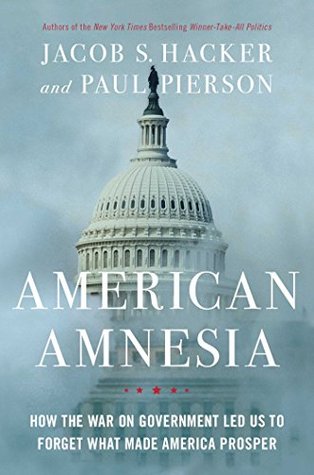More on this book
Kindle Notes & Highlights
Read between
October 17 - October 17, 2023
“The Constitution was not meant to hold the government back to the time of horses and wagons,”
He even supported an absolute federal veto over all state laws, likening it to “gravity” in the Newtonian framework of the new federal government.
The position embraced by George Will and other self-proclaimed “constitutional conservatives” isn’t the position of James Madison. It’s the position of those who opposed creating the Constitution in the first place.
Tocqueville himself worried that the deep patriotism of Americans sometimes prevented a “reflective” assessment of their nation’s strengths and weaknesses.
(Between 1980 and 2008, according to Google’s catalog of English-language books, the number of references to “American exceptionalism” increased almost eightfold.)
Romney dismissed the “rugged individualism” touted by conservatives as “nothing but a political banner to cover up greed.”
the social institution of the mixed economy could have been updated to respond to these changes. The balance between effective public authority and dynamic private markets could have been recalibrated rather than rejected.
So it’s striking that Americans are no longer the tallest people in the world. Not even close: Once three inches taller than residents of the Old World, on average, Americans are now about three inches shorter. The average Dutch height for men is six foot one, and for women, five foot eight
Unfortunately, not only is the United States having trouble clearing the low bar; it is barely even trying to clear the higher one.
Another area where the United States was once the undisputed leader is education.
Older Americans are the most educated in the world. Younger Americans, not even close.
Inequality of opportunity begins early, and it costs everyone. Good pre-K education, for example, more than pays off in higher growth and tax receipts and lower public costs, from social assistance to incarceration.
Where did all the growth go? The answer, it turns out, is simple: It went to the top, especially the very top.
The richest 1 percent own more than a third of the nation’s wealth; the top 10 percent, more than three-quarters.74 No other rich country comes close to this level of concentration at the top.
The United States now ranks ninth in the world in government R&D expenditures
The majority of this spending, however, is for defense-related projects, which have fewer positive spillovers than nondefense R&D
Take out defense, and the United States ranks thirty-ninth in government R&D spending as a share of the economy.
China and India are spending almost 10 percent of GDP on infrastructure; Europe, around 5 percent.96 Even Mexico spends just over 3 percent.97 The United States has not broken 3 percent once since the mid-1970s.
One soda a day—a twelve-ounce can, not the megacups that are served at fast-food restaurants (KFC’s “Mega Jug” is sixty-four ounces)—adds up to 55,000 additional calories and fifteen extra pounds a year.
Massive public investments in science training, communications, transportation, roads, bridges, and R&D continued after the war, emphasizing civilian as well as defense aims.
Virtually all were promoted by large-scale public funding of research and development.
But private drug companies never played a major role,
When it came to vaccines, the free market failed.
Some people had to be compelled to be vaccinated. In the United States and elsewhere, they were—most effectively, by requiring that children receive vaccines when entering public school.
“Had it been left to private markets during the last few decades, it is inconceivable that today some 80 per cent of the world’s children would be immunized against the six major vaccine-preventable childhood diseases.”
The role of the federal government in developing penicillin was even more direct.
Federal scientists working for the US Department of Agriculture did much of the pioneering research, quadrupling yields in a matter of months.
the US federal government patented many of the production processes and shared them freely with companies.48 But under this open-source model, private industry thrived.
The MRI (magnetic resonance imaging) emerged from a series of National Science Foundation grants starting in the mid-1950s.
laser, also vital to medical practice as well as consumer electronics and much else, grew out of military-funded research.
a 1995 investigation by researchers at the Massachusetts Institute of Technology (MIT) found that government research had led to eleven of the fourteen most medically si...
This highlight has been truncated due to consecutive passage length restrictions.
The highly successful campaign against smoking was a public campaign: Tobacco companies fought tenaciously against efforts to inform consumers about the risks of smoking or shift the societal costs of smoking onto tobacco companies and their customers through taxation and regulation.
they make clear that the critical ingredient, paradoxically, is not private freedom but public constraint:
Modern growth occurred where, and only where, activist government emerged.98
Perhaps the most important thing that big states do is educate their citizens.
But for reasons well understood by generally market-appreciative thinkers from Adam Smith to Milton Friedman, mass schooling has never occurred in the absence of government leadership.106
Government has been a much more important and direct influence on the direction and rate of technological innovation than much of our national ideology and public rhetoric would lead us to suppose.”108
In the nineteenth century, the corps even loaned officers to corporations to help with engineering projects—in effect subsidizing private infrastructure.122


